Peru connection with Central America?
A myth still lingers in Northern Peru, said to be a myth passed on by by-gone civilisations, particularly associated with the Sicán but also the Chimú. It goes something like this.
The Moche civilisation had collapsed, and the people of the region had reverted to simple farmers lacking organisation or a central focus. The glorious times of monument building were over, the people disillusioned with the old religion they represented. Their sacrifices brought them drought and floods, not the stability they had hoped for.
It was into this scene that one day arrived a fleet of small sea-fearing vessels from the north. The lead boat landed on the beach and a man, named Naylamp, dressed in exotic riches stepped ashore.
Wearing gold ornaments and an elaborate headdress of hundreds of strange exotic feathers unknown to the region, the man said to have great talent and courage beaconed the other ships to follow.
The local Moche descendants, so impressed with this mysterious man from the ocean, bowed at his feet, one woman offering him food and water. He married this woman and set about organising the people into a city and eventually a nation state. The Sicán civilisation had begun.

An impressive story. Some say there may even be a connection between the fall of the Maya in Mexico and the rise of the Chimú and Sicán, which occurred at the same time. The truth is though, if this was the case, the Maya would have almost certainly brought their written language with them. The story may still have some truth in it though, nearby Ecuador and Colombia have their fare share of exotic birds and interesting past cultures. We do know there was pre-Inca trade with central America, which is why we have corn in Peru, some theorise there were even direct trade links with central America.
There does seem to be some evidence though of a group of people arriving from the north and starting a civilisation in the region.
Cronicalist Cabello de Balboa, in 1586 heard the story from locals in Lambayeque and first told it to the Spanish. Later, famous archaeologist Bruning in the early 1900s indicated that the river Faquisllanga in Lambayeque may have been the arrival point where Naymlap constructed his palaces and temples. In the ancient ruins of these constructions he found an emerald idol (Emeralds are a national export of Colombia).
The truth is we know so little, it is impossible to tell fact from fiction, be that fiction wild or not.
Tags: central america, chimu, maya, mexico, moche, naymlap, sican










